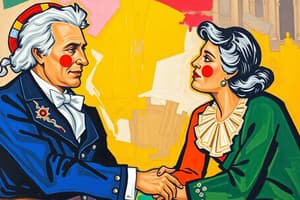Podcast
Questions and Answers
What marked the Era of Good Feelings?
What marked the Era of Good Feelings?
a sense of national purpose and a desire for unity among Americans in the aftermath of the War of 1812
Who was president during the Era of Good Feelings?
Who was president during the Era of Good Feelings?
James Monroe
How did the Jeffersonian Republicans gain influence after 1800?
How did the Jeffersonian Republicans gain influence after 1800?
due to the decline of John Adam's Federalist party and popular support for Jefferson
What happened between 1809-1816 that caused a change in political dynamics?
What happened between 1809-1816 that caused a change in political dynamics?
James Monroe's changes include a change in protection of domestic policy under ____ ____.
James Monroe's changes include a change in protection of domestic policy under ____ ____.
James Monroe's changes involved major internal improvements to _____ and _____.
James Monroe's changes involved major internal improvements to _____ and _____.
A shift in _____ policy leads to major national ____.
A shift in _____ policy leads to major national ____.
There was a movement from ____ to _____ in the U.S.
There was a movement from ____ to _____ in the U.S.
Who is known for the American system?
Who is known for the American system?
What led to the passage of the Tariff of 1816?
What led to the passage of the Tariff of 1816?
What were key characteristics of the American System?
What were key characteristics of the American System?
Why did the South disagree with the American System?
Why did the South disagree with the American System?
What led to U.S. expansion during this period?
What led to U.S. expansion during this period?
What characteristics of the period led historians to argue that it was an era of nationalism?
What characteristics of the period led historians to argue that it was an era of nationalism?
What were the causes of the U.S. financial crisis in the Panic of 1819?
What were the causes of the U.S. financial crisis in the Panic of 1819?
What were the effects of the U.S. financial crisis during the Panic of 1819?
What were the effects of the U.S. financial crisis during the Panic of 1819?
How does the election of 1820 map show an increase in nationalism?
How does the election of 1820 map show an increase in nationalism?
Was there a movement from nationalism to sectionalism with James Monroe?
Was there a movement from nationalism to sectionalism with James Monroe?
What was the Missouri Compromise?
What was the Missouri Compromise?
The _____ _____ to Missouri Compromise is known as the Tallmadge Amendment.
The _____ _____ to Missouri Compromise is known as the Tallmadge Amendment.
Why was the Tallmadge Amendment controversial?
Why was the Tallmadge Amendment controversial?
Flashcards are hidden until you start studying
Study Notes
Era of Good Feelings
- Characterized by national unity and purpose following the War of 1812.
- James Monroe served as president from 1817 to 1825.
Rise of Jeffersonian Republicans
- Federalist Party declined post-1800 due to unpopular policies (e.g., Alien and Sedition Acts).
- Jefferson's election in 1801 marked a shift; he gained strong backing in the South and West.
- Jefferson's 1804 re-election was bolstered by the Louisiana Purchase.
Events from 1809-1816
- Trade wars and foreign policy issues arose from 1810 to 1812.
- The War of 1812 fostered stronger nationalist sentiments.
Domestic Policy Changes
- Monroe’s administration implemented the American System.
- Focused on infrastructure and transportation improvements.
Shift to Nationalism
- Transitioned from nationalism to sectionalism in domestic policies and ideologies.
Henry Clay and the American System
- Advocated for the American System, emphasizing strong federal involvement in the economy.
Tariff of 1816
- Introduced to protect American manufacturing by raising prices on imported goods.
- Resulted from post-war competition with cheap British goods and aimed to stimulate the economy.
Characteristics of the American System
- Included the Tariff of 1816, establishment of the Second Bank of the United States, and federal funding for internal improvements.
Southern Opposition to American System
- Fears that federal economic policies could inadvertently threaten slavery.
U.S. Expansion Factors
- Treaties such as the Rush-Bagot Treaty and Adams-Onis Treaty facilitated territorial growth.
- The Convention of 1818 established secure U.S.-Canada borders and access to Oregon.
Nationalism in Historical Context
- The War of 1812 intensified national pride.
- Loss of the Federalist Party’s influence highlighted unity and nationalism.
- The Tariff of 1816 and support for the Second Bank of the U.S. indicated political and economic cohesion.
Panic of 1819: Causes
- Heavily borrowed government funds for the War of 1812 destabilized finances.
- The Bank of the United States issued risky loans, contributing to inflation and a real estate bubble.
Panic of 1819: Effects
- Resulted in widespread bankruptcy, bank failures, and unemployment.
- Sparked debates over tariffs and monetary policies, revealing suspicion toward the national bank.
Election of 1820
- James Monroe’s overwhelming Democratic-Republican support reflected burgeoning nationalism.
Sectionalism Emergence
- Monroe's presidency illustrated a shift from unity to sectional tensions, particularly over slavery.
Missouri Compromise (1820)
- Admission of Missouri as a slave state countered by Maine’s admission as a free state.
- Established the 36°30' line to regulate future state admissions regarding slavery.
Tallmadge Amendment
- Proposed to gradually free slaves born in Missouri after statehood.
- Passed in the House, but faced strong Senate opposition, highlighting sectional divides.
Controversy over the Tallmadge Amendment
- Initiated debates around slavery expansion and intensified sectional tensions, particularly during the Missouri Compromise discussions.
Studying That Suits You
Use AI to generate personalized quizzes and flashcards to suit your learning preferences.




